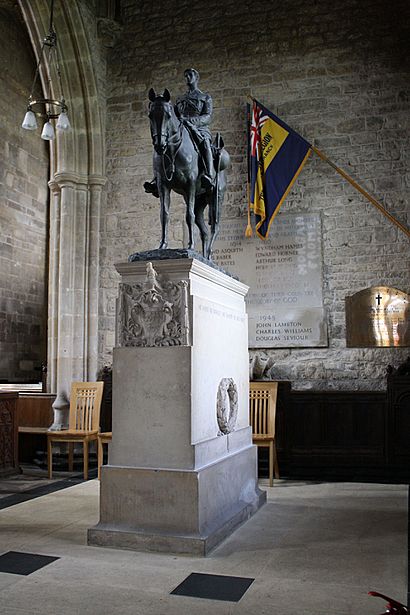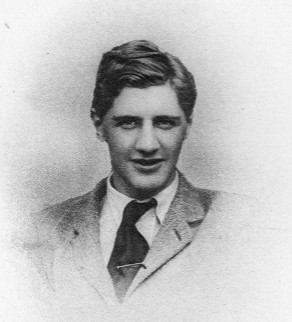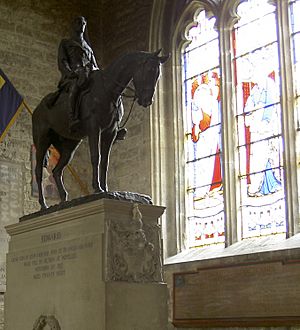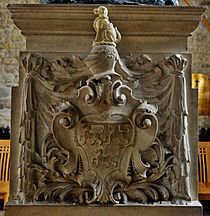Equestrian statue of Edward Horner facts for kids
Quick facts for kids  |
|
| Artist | Alfred Munnings (statue) Sir Edwin Lutyens (plinth) |
|---|---|
| Completion date | 1920 |
| Type | Sculpture (Equestrian statue) |
| Medium | Bronze |
| Subject | Edward Horner |
| Location | Mells, Somerset, England |
| 51°14′32″N 2°23′28″W / 51.2421°N 2.3912°W | |
The equestrian statue of Edward Horner is a special memorial inside St Andrew's Church in the village of Mells, England. It was created to remember Edward Horner, a young man who sadly died from his wounds during the First World War. The famous architect Sir Edwin Lutyens designed the base of the statue, and the well-known artist Alfred Munnings sculpted the bronze horse and rider.
Edward Horner was the only son of Sir John and Lady Frances Horner, who lived at Mells Manor. He was part of a group of friends called "the Coterie." Many young people from this group, including Edward, died in the war. Edward was a soldier in the Territorial Force when the war began. He really wanted to fight on the Western Front. His family helped him transfer to a cavalry regiment.
He was hurt in May 1915 but returned to the war in 1917. He got another job away from the front lines, but he wanted to fight again. On November 21, 1917, he was wounded once more and died that same day.
Sir Edwin Lutyens was a friend of the Horner family. He had designed many buildings for them. For Edward's memorial, Lutyens designed the stone base. He asked Alfred Munnings, a famous painter of horses, to create the statue. The statue shows a cavalry officer on horseback. It was placed in the Horner family chapel in 1920. In 2007, it was moved to a different part of the church.
Contents
Who Was Edward Horner?
Edward William Horner was born on May 3, 1888. He was the first son of Sir John Horner and Frances (née Graham). The Horner family was thought to be related to "Little Jack Horner" from the old nursery rhyme. Edward's father was a barrister and later worked for the government. His mother, Frances, was a well-known member of a social group called "the Souls." She often hosted gatherings at Mells.
Edward was the last direct male heir of the Horner family. His younger brother, Mark, had died from scarlet fever before the war. Edward went to Summer Fields School, Eton College, and Balliol College, Oxford. At Oxford, he joined the Officers' Training Corps. He also became part of "the Coterie" social group. Many of his friends from this group often visited Mells Manor.
Edward tried to become a barrister, following his parents' wishes. He started working with a famous barrister in 1914.
Edward's War Service
Like many young men at the time, Edward felt very patriotic. This feeling came from his schooling and stories about military campaigns. On August 19, 1914, he became a second lieutenant in the North Somerset Yeomanry. This was a part-time army unit.
When the First World War started in August 1914, Edward's unit went for training. Edward really wanted to fight in France. His influential family helped him transfer to the 18th (Queen Mary's Own) Hussars. This cavalry regiment was sent to the Western Front in early 1915.
Edward arrived in France in February 1915. In May 1915, he was helping to dig trenches. He was wounded in the stomach by shrapnel from an artillery shell. He had a kidney removed in the hospital. His parents were allowed to visit him because his condition was so serious. He returned home to Mells to recover.
Edward wanted to go back to the front lines. In December 1915, doctors said he couldn't fight because he only had one kidney. He was sent to Egypt instead. He was promoted to temporary lieutenant in November 1916.
His Final Battle
Edward first had a staff job in Egypt. But he managed to transfer back to a fighting role in France in February 1917. In October that year, his family's second home burned down. Edward got special leave to visit his parents in Mells.
When he returned to France, he was given command of a troop of soldiers and horses. His regiment, the 18th Hussars, was part of the Battle of Cambrai. They were defending the village of Noyelles. On November 21, 1917, Edward was hit in the groin. He was taken to a medical station but died that evening.
Edward Horner is buried in the Rocquigny-Equancourt Road British Cemetery. This cemetery is looked after by the Commonwealth War Graves Commission. His grave in France has a special message from Shakespeare's play Henry V: "Small time, but in that small most greatly lived this star of England."
Creating the Memorial
Sir Edwin Lutyens was one of Britain's most famous architects. He designed many war memorials, including The Cenotaph in London. Lutyens was a friend of the Horner family. He had worked on their home, Mells Manor, and its gardens. He also designed other memorials in Mells, including one for Edward's brother-in-law, Raymond Asquith.
Alfred Munnings was a painter known for his horse paintings. He wanted to join the army but couldn't because of his eyesight. He later became a war artist. In 1919, he started making sculptures. The Edward Horner memorial was his first public sculpture. Lutyens asked Munnings to create it because they were friends. Munnings made two clay models for Lady Horner to approve. He used photos of Edward and a live model to create the statue.
About the Statue
The memorial is inside St Andrew's Church in Mells. The Horner family has a long history with this church. They even have their own chapel there. The statue is a bronze equestrian statue. It shows Edward Horner as a young cavalry officer, without his helmet, riding a horse. His sword and helmet are on the horse's saddle.
The statue stands on a base made of Portland stone, designed by Lutyens. This base is similar to his famous Cenotaph. The temporary wooden cross that marked Edward's grave in France is placed on the back of the base. The Horner family's coat of arms is carved into the front. The sides of the base have special messages. One side says: "EDWARD / DEAR SON OF JOHN HORNER AND FRANCES HIS WIFE WHO FELL IN ACTION AT NOYELLES NOV 21 1917 AGED TWENTY EIGHT." The other side has a line from a poem by Percy Bysshe Shelley: "HE HATH OUTSOARED THE SHADOW OF OUR NIGHT."
Many people believe Edward Horner's statue is one of the most touching personal memorials from the First World War. Lutyens often used simple, abstract designs for public war memorials. But for memorials to individuals, he sometimes used more traditional images, like a statue of a soldier.
The statue was put in place in 1920. It cost over £1,000. It was the largest and most detailed war memorial in Mells. Lady Frances Horner wanted it under the church's bell tower. But villagers and church leaders didn't agree. So, it was placed in the Horner family chapel. In 2007, it was moved to the west end of the church's north aisle. This move helped create more space for other church activities.
See also
 In Spanish: Estatua Ecuestre de Edward Horner para niños
In Spanish: Estatua Ecuestre de Edward Horner para niños






